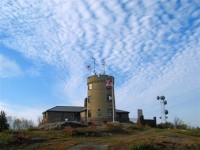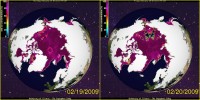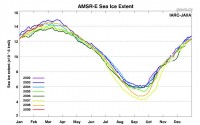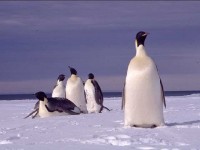Feb 23, 2009
Blue Hill Observatory, MA: January Was in Some Ways Extraordinary
Blue Hill Observatory Newsletter Item

Blue Hill Meteorological Observatory, located at the top of a scenic mountain range south of Boston at an elevation of 635 feet, is a unique American institution. Founded in 1885 by Abbott Lawrence Rotch as a private scientific center for the study and measurement of the atmosphere, it was the site of many pioneering weather experiments and discoveries. The earliest kite soundings of the atmosphere in North America in the 1890s and the development of the radiosonde in the 1930s occurred at this historic site. It is home to the longest continuous history of weather observations in the United States. By combining data from nearby Milton and Canton, adjusted to Blue Hill, the data stretches back to 1831.
Today, the Observatory is a National Historic Landmark and remains committed to continuing its extensive, uninterrupted climate record with traditional methods and instruments. The recently established Science Center expands this mission by enhancing public understanding of atmospheric science. We are grateful for the generous support of members, friends, and corporations who make it possible to continue our benchmark climate observations and educational outreach programs. Please contact Charles Orloff by phone: (508) 776-1879 or email if you would like to make a donation to the Observatory. Sign up for our regular emails here. See our data here.
January 2009 Temperature & Wind; December-January snowfall
TEMPERATURE
The temperature in January never made it above 39 degrees, which is a new record for the lowest Monthly Maximum Temperature on record for the month of January.
January Coldest Maximum Temperature (deg F)
1) 39 in 2009
2) 40 in 2003
3) 41 in 1896
41 in 1948
5) 42 in 1925
42 in 1941
42 in 1985
The average monthly temperature of 21.8 degrees was about 25th coldest on record and only coldest since 2004.
Coldest January average temperatures (deg F)
Jan. 1920....15.5
Jan. 1888....16.3
Jan. 2004....17.2
WIND
The average corrected monthly mean wind speed of 13.1 MPH was the second lowest for any January on record checked back to 1885.
January Lowest Wind Speed (MPH)
1) 12.2 in 2001
2) 13.1 in 2009
3) 13.3 in 1984
4) 13.4 in 2005
5) 13.9 in 2008
The peak gust of 48 MPH is second lowest on records for January checked back to 1965 (behind 43 MPH in 2001). Prevailing wind direction from west at 36% is an unusually high percentage.
SNOWFALL
The December-January snowfall total of 55.1 inches is the 7th greatest on record.
Dec-Jan Highest Snowfall (inches)
1) 95.8 in 1947-48 [136.0 seasonal total]
2) 72.9 in 1995-96 [144.4 seasonal total]
3) 67.8 in 1922-23 [102.5 seasonal total]
4) 62.0 in 1903-04 [103.4 seasonal total]
5) 61.0 in 2004-05 [119.4 seasonal total]
6) 57.1 in 1945-46 [91.2 seasonal total]
7) 55.1 in 2008-09
8) 49.6 in 1976-77 [81.2 seasonal total]
There were no new daily records in the month of January.
Feb 21, 2009
Sea Ice Sensor Degradation Hits Cryosphere Today
By Anthony Watts, Watts Up With That
You may recall that I posted about how the National Snow and Ice Data Center has an issue with the DMSP satellite sensor channel used to detect sea ice. Cryosphere Today is a few days behind in update compared to NSIDC, and here is what their imagery now looks like before and after:

Here is the link to reproduce the image above.
Larger “holes” are likely to open up in the arctic sea in the next couple of days as the sensor further degrades.
Here is what CT has to say as a caveat for the side by side images:
February 17, 2009 - The SSMI sensor seems to be acting up and dropping data swaths from time to time in recent days. Missing swaths will appear on these images as a missing data in the southern latitudes. If this persists for more than a few weeks, we will start to fill in these missing data swaths with the ice concentration from the previous day. Note - these missing swaths do not affect the timeseries or any other plots on the Cryosphere Today as they are comprised of moving averages of at least three days.
No mention of the issue on CT’s main page though. They are still commenting on George Will. They seem a bit out of touch on the sensor issue.
h/t to Garrett
UPDATE: 11:30PM 2/20 CT has removed the comments about George Will from the main page, but still no mention there of the satellite outage nor are they displaying imagery on the main page from 2/20/09 The most recent is 02/19/09. It will be interesting to see what tomorrow brings. See Anthony’s post and comments here.
Icecap Note: the AMSR_E still is providing the most accurate data. It shows the following (larger image here) with the value of 14,032,188 square kms as of February 20, 2009:

See their mapping of the ice here.

Anthony Watts also posted posted on this issue with a response from Dr. Walt Meier at NSIDC that the error related to satellite imaging dropout, mainly ice in Hudson Bay that went “missing” in the scan. Anthony explains why posting on these data discrepancy, questioned by Dr. Meier is valid.
See also NSIDC’s description of the problem, a failing satellite and why they chose to continue to use the older DMSP SSM/I data satellite data than to go to the newer more reliable and accurate satellite AMSR-E here.
Feb 21, 2009
Western Climate Plan Could Prolong Recession, Weaken Power Grids but Not Change Temperature
Western Business Roundtable
Plan Could “Chase Away” Tens of Billion Of Dollars In High-Tech Investment From Western States
Denver, CO (Feb. 18, 2009)—A new study says that a climate action plan promoted by several Western governors could prolong the economic recession, weaken already overburdened Western power grids and will deliver a temperature “benefit” of only one ten-thousandth of a degree Celsius even after a century of operation. The study, commissioned by the Western Business Roundtable, found that the Western Climate Initiative (WCI) greenhouse gas (GHG) cap-and-trade plan could “chase away tens of billions of dollars in high technology investment from the West to other regions” and would “further stress the West’s already strained electricity grid, increasing the threat of potentially catastrophic power outages.”
“The key to creating new jobs while reducing emissions is not to throttle back our economic engine, but to turbo-charge it with new technologies that allow it to run faster, cleaner and more efficiently,” said Jim Sims, President and CEO of the Western Business Roundtable. “The analysis we commissioned predicts that the WCI would disadvantage the West by limiting energy resources and discouraging deployment of new technologies that can help us grow to a more low-carbon economy,” Sims said. “On the contrary, the West needs all the resources we can develop in order to power our way out of this recession and create millions of new high-paying jobs. We need a climate action plan that helps our economy grow while we continue to reduce emissions through cutting-edge, 21st century technologies.”
The analysis of the WCI plan was conducted by Management Information Services, Inc., a highly regarded economic analysis firm that conducts studies for both renewable and fossil energy organizations. The WCI’s proposed regional cap-and-trade plan was unveiled last September by the governors of California, Utah, Arizona, New Mexico, Oregon, Washington, and Montana. Details on that plan can be seen here.
The study unveiled three findings that Sims said were “a bit shocking.” The first was the WCI plan’s assumption that virtually no baseload power plants would be deployed in the West through the year 2020 fueled by either hydropower, natural gas, coal or nuclear energy, even though nearly all experts predict that the West will experience significant growth in energy demand and will need more baseload power plants to maintain reliability. The second finding was that the WCI recommends that virtually all growth in the West’s electricity demand should be met by mostly intermittent power generation, such as solar and wind farms, and demand reduction. Most experts believe that such a rapid and large deployment of highly variable power sources onto the region’s electrical grid would greatly increase the risk of system failure.
“If the WCI is in fact recommending that we deploy virtually no new baseload power plants, that we and rely solely on renewables and demand destruction, this is a proposal that would weaken the Westís already over-burdened high-voltage transmission grid and could easily deepen or lengthen our economic recession,” Sims said. “President Obama understands the need to aggressively and rapidly build next-generation baseload power plants, including those that capture and sequester GHGs. He knows, as do policymakers across the West, that economic growth is closely tied to availability of affordable energy and a stable and reliable energy infrastructure and that carbon management policies must balance environmental goals with the demands of economic recovery and job creation.”
The third finding is that “the very climate science now driving climate policy in Congress, that of the United Nation’s Intergovernmental Panel on Climate Change, predicts that the WCI plan would result in a virtually immeasurable reduction of future global temperatures over the next century of one ten-thousandth of a degree Celsius.” “We were frankly a bit shocked by this last finding, but the numbers come straight from the IPCC science and they pretty much speak for themselves,” Sims said. “If the IPCC’s own scientific assumptions and climate change formulas predict such a meager temperature benefit from scenarios that range from the WCI plan all the way to shutting down all fossil fuel power plants in America 100 years, it casts a long shadow on those who say we must take extreme action now without thinking through the entire cost-benefit equation.
The analysis also warned that the WCI plan could result in the following: The WCI plan could increase energy costs and disproportionately harm low-income and minority families, particularly minority families who are among the most vulnerable to price shocks. The WCI’s plan to establish and monitor emissions caps would require the establishment of a large and powerful new government bureaucracy. This could trigger the type of influence-peddling and system “gaming” that has plagued European experiments with such regulatory approaches.
The laws, regulations, mandates and bureaucracy the WCI is proposing go so far as to give WCI climate officials authority even over private companiesí organization and reorganization functions. The Roundtable analyzed the WCI plan according to how it addressed four basic objectives: Would it contribute to increased reliability of the regionís energy production and delivery infrastructure - would it help “keep the lights on” as the West works to create new jobs and pull itself out of economic recession? Would it stimulate new technology investment across the region, especially on carbon capture and sequestration technologies, so that the West can participate in, and benefit from, the deployment of these technologies? Would it deliver measurable and recognizable environmental benefits - measured in terms of reduced future global temperature - to consumers who will pay the costs of these programs and who often view the efficacy of government mandates through the lens of costs versus benefits? Does it strengthen the West’s bargaining position in the upcoming federal policy debates over national GHG mitigation measures?
“This analysis concludes that the WCI plan does not meet any of these objectives,” Sims concluded.
Feb 20, 2009
Climate Realism from Biologist and Polar Researcher Bernard Stonehouse
By Tom Nelson
Biologist and polar researcher Bernard Stonehouse works out of Cambridge when he’s not giving talks on wildlife and environment on cruise ships sailing in Antarctic waters. He tells Narayani Ganesh that Antarctica is probably the most unspoiled continent on Earth, despite its growing popularity among tourists:
The evidence present in ice cores does suggest that there have been wide changes in temperatures. So while in the peninsular region there has been increase in daily temperatures, this has not been the case in the plateaus. I expect temperatures in Antarctica to be more resistant to warming effects than those of tropical regions because there is so much accumulated cold here. The Antarctic is much colder than the Arctic, for instance. So the Antarctic is not the first place to look for evidence of global warming.
[Q] What do you think of climate change naysayers? (note Bernard apparently understood alarmists)
Well, it is easy to frighten people, especially when alarmist stories are widely reported in the media. The other thing is that scientists who are desperate for research funds might find that generating fear is a good way to generate funds for further research in these areas. I would say that even if there is no definite evidence of accelerating climate change, it is beneficial to be cautious and take care of the environment. I have no evidence of the impact of climate change on species, of whether plant growth is increasing or penguins are moving to other areas.

Icecap Note: Reminds me of my 8th grade teacher
In the 60 years I’ve worked in the Antarctic, I have found that some stocks of penguin have disappeared from particular places, only to increase in numbers elsewhere. The USA’s Palmer science station found that sea ice is declining and sea ice is the nursery for krill, the creatures that the Adelie penguins and other sea animals feed on. The depletion in krill numbers in some areas might force penguins and other animals to migrate to other areas.
See more here.
Feb 18, 2009
The Real Truth About AGW
By Richard Courtney
Sirs, you say: “And perhaps some scientists are coming out against the idea that humankind has warmed the planet and continues to spew increasing pollutants into our atmosphere. If so, they are awful quiet about their challenge. Perhaps they should post their arguments here and let NRDC’s real climate experts take them on.”
Well, I am an Expert Peer Reviewer for the UN Intergovernmental Panel on Climate Change (IPCC); i.e. I am one of the often touted “thousands of UN Climate Scientists”. I and thousands of others speak, publish and sign petitions in attempt to get the media to tell the truth of man made global climate change. And in response to your invitation I post that truth below.
The AGW-hypothesis asserts that increased greenhouse gases (GHGs) - notably carbon dioxide - in the atmosphere will cause the globe to warm (global warming: GW), and that anthropogenic emissions of carbon dioxide are increasing the carbon dioxide in the air with resulting anthropogenic (i.e. man-made) global warming (AGW).
I think a clear distinction needs to be made between (a) the science of AGW, and (b) the perception of AGW - and the use of AGW - by non-scientists.
The present empirical evidence strongly indicates that the AGW-hypothesis is wrong; i.e.
1. There is no correlation between the anthropogenic emissions of GHGs and global temperature.
2. Change to atmospheric carbon dioxide concentration is observed to follow change to global temperature at all time scales.
3. Recent rise in global temperature has not been induced by rise in atmospheric carbon dioxide concentrations. The global temperature fell from 1940 to 1970, rose from 1970 to 1998, and fell from 1998 to the present (i.e. mid-2008). This is 40 years of cooling and 28 years of warming, and global temperature is now similar to that of 1940. But atmospheric carbon dioxide concentration has increased at a near-constant rate and by more than 30% since 1940.
4. Rise in global temperature has not been induced by increase to anthropogenic emissions of carbon dioxide. More than 80% of the anthropogenic emissions of carbon dioxide has been since 1940, and the increase to the emissions has been at a compound rate of ~0.4% p.a. throughout that time. But that time has exhibited 40 years of cooling with only 28 years of warming, and global temperature is now similar to that of 1940.
5. The pattern of atmospheric warming predicted by the AGW hypothesis is absent.The AGW hypothesis predicts most warming of the atmosphere at altitude distant from polar regions. Radiosonde measurements from weather balloons show slight cooling at altitude distant from polar regions.
The above list provides a complete refutation of the AGW-hypothesis according to the normal rules of science: i.e. Nothing the hypothesis predicts is observed in the empirical data, and the opposite of the hypothesis’ predictions is observed in the empirical data.
But politicians and advocates adhere to the hypothesis. They have a variety of motives (i.e. personal financial gain, protection of their career histories and futures, political opportunism, etc.). But support of science cannot be one such motive because science denies the hypothesis. Hence, additional scientific information cannot displace the AGW-hypothesis and cannot silence its advocates (e.g. Hansen). And those advocates are not scientists despite some of them claiming that they are. Read blog here.
|







